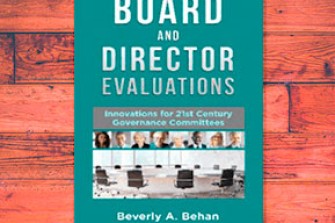Organisational performance monitoring is an essential means by which a board discharges its accountability. It is the process by which a board checks that the performance criteria it has set have been met.
The sense that ‘the more information we have the better we are doing our job’ is widespread among board members. Given increasing performance expectations (and legal liabilities!), this is understandable. However, this attitude is highly problematic. The wider the scope and the more detail in the board’s monitoring efforts, the more likely it won’t be able to see ‘the wood for the trees’.
Apart from fulfilling a board’s fiduciary duties, effective and efficient monitoring is central to maintaining a good board/management relationship. However, the time a board has for effective performance monitoring is inherently limited. So, boards must find the (relatively few) leverage points that are essential for organisational performance and focus their own monitoring and decision making at those points. Put simply, they must differentiate between ‘need to know’ and ‘nice to know’.
The key to doing this is to ensure that the board’s monitoring is ‘criterion-referenced’. This means ensuring that monitoring is based on predetermined performance criteria that reflect the board’s sense of what is really important. Cues to this are likely to be found in:
- the fundamental purpose of the business and the outcomes it must deliver to fulfil that purpose
- how the organisation functions to fulfil that purpose
- the environment within which the organisation operates and the consequent risks and opportunities; and, not least…
- stakeholder expectations.
Only when a board has a clear sense of the most important performance criteria can it start to get the high quality information that will enable it to monitor how the organisation is tracking. In contrast, the way many boards search for monitoring data is not nearly as purposeful.
For many boards this is partly historical. Management prepare, and boards receive, the same old reports they always have even long after the information is relevant (if it ever was). If questioning existing practice is all it takes, this can be easily fixed. All it takes is for one new board member to come along and say: “what do we do with all this stuff?”
Other situations, however, may be a greater challenge. Perhaps the board doesn’t have clear answers to the question of what is really important and what relevant performance criteria might look like. Perhaps (if such criteria do exist) management is not reporting cogently and concisely against them. Whatever the cause of the problem, the following reference points might help your board to get back on the right track. This will benefit both board and management.
1. Ensure monitoring is systematic
Reporting to the board is the bane of many chief executives’ lives. Few boards give explicit instructions to their chief executive about what they wish to be monitored and thus what they expect will be reported. This leaves chief executives having to second-guess their board’s requirements. Understandably, therefore, chief executives are inclined to over-report—going into great detail so that they will not be caught out.
So, the board must first determine what results or actions are important in the overall scheme of things. These should be reflected in explicit strategic and policy pronouncements. When the board has set criteria for what must be achieved and situations or circumstances that must be avoided, the chief executive is obliged to report against these criteria (and only these criteria). The board should also make clear to the chief executive how (ie, in what form) such criteria should be reported against.
2. Ensure monitoring criteria are clear and relevant to the governance role
One reason why so few boards express their monitoring requirements clearly is that directors often do not know, other than in the most general terms, what they need to monitor. The organisation’s finances are an obvious focus, but exactly what financial information should they monitor?
Certain operational elements are critical to achieving the desired outcomes, but which of these are relevant to the board and which are strictly management matters? Directors know that they should be adding value to the work of the chief executive and staff, but where and how? So, what they should monitor, and how?
3. Determine the extent to which directors need to understand the business
A common misconception is that effective governance requires a highly detailed knowledge about ‘what is going on’ in the business being governed. A board’s role is to govern the organisation, not manage it, and to this end, directors should be experts in governance not operations.
They do not need to be experts in the business in the sense that staff are or are expected to be. What they do need to know is what is really important to the performance of the business. What are the performance factors that make the difference between success and failure? These become the focus of the board’s attention and its on-going learning and monitoring.
Many boards spend their time poring over pages of immaterial, if not irrelevant, reporting. Too much data can be as inhibiting to effective monitoring as too little. A key competency of good boards is that they make it clear to their chief executives not only what they want reported and how, but how much depth or detail is necessary to enable effective monitoring.
4. Ensure that monitoring is based on policies
To ensure that organisational success is maximised and failure is minimised when the board only works on the business episodically (typically no more frequently than monthly), the board must, in a sense, do its job by remote control. That is the essence of the board’s policy-making function.
Policies provide a criterion reference from which all board and chief executive action and decisions flow. Policies make clear to everyone what is to be achieved and what is, or is not, to be done. This makes the board’s monitoring function relatively simple. Have the results been achieved—or not? Have undesirable situations or circumstances been avoided—or not?
Chief executives can assume that if the board has developed and adopted a policy that relates to his/her work, there is an obligation to report to the board on the implementation of that policy. By establishing what is important, the board’s policy framework thus sets the basis for systematic monitoring.
5. Allow and respect the chief executive’s choices
Many boards are blessed with board members with extensive skills and experience relevant to the business of the organisation. These same board members can, however, become a liability when they try to impose their own views about how the work should be done on the chief executive to whom operational decision making has been delegated. It is not a sensible division of labour for a board to hire a competent chief executive and then tell him/her what actions or decisions to take. Nor is it reasonable to allow individual directors to judge chief executive performance in terms of how they would have approached the same issue themselves.
The board’s interest in how the chief executive goes about his/her job should be defined by the criteria stated in its policies. If a board wants to narrow down its chief executive’s choices of operational means, this can and should be made explicit in proscriptive or ‘limitation/powers withheld’ policy terms. If the board has developed a policy framework providing a clear set of performance expectations, it must allow the chief executive to exercise a reasonable interpretation of those policies.
Allowing the chief executive to make operational choices can be hard for some board members to accept. This is especially true when they have relevant expertise themselves or there is stakeholder pressure to do things in a particular way. Boards that cannot do this risk taking over the chief executive’s decision-making responsibility and undermining the board’s ability to hold him/her accountable.
If the board does its policy-making job well, there is no danger of the chief executive’s ‘tail’ wagging the board’s ‘dog’. The board is always in control—via its own policies that provide direction and determine the extent of chief executive decision-making freedom. The board must, however, exercise that control ethically and fairly. Even when the board (or some other party) does not like the chief executive’s choice of action, its criteria for judgement must still be the policy. In choosing the action, did the chief executive made a reasonable interpretation of the board’s policy as it stood at the time? This is simply a matter of natural justice.
If a chief executive’s efforts to achieve the desired outcomes are consistent with the board’s policy ’goal posts’, the board must accept his/her decisions. If the outcome is not what the board envisaged, the problem is more likely to be with the policy than the action.
Conclusion
The board’s responsibility is to ensure that everything related to the organisation is as it ought to be. Policies are the most effective means for saying how things ought to be. Monitoring compliance with those policy criteria is the method by which the board enacts these principles. Boards that grasp this concept suddenly find their monitoring role is not only much easier to define and carry out, but also much more effective.
Without effective (ie, appropriate) monitoring, a board cannot guarantee to fulfil its ‘duty of care’ and cannot assure its owners and key stakeholders that it is doing a good job on their behalf. Without efficient monitoring, a board cannot devote its time and attention to matters of real importance to the success of the organisation. Such a board cannot demonstrate good governance. Such a board cannot see the wood for the trees.








